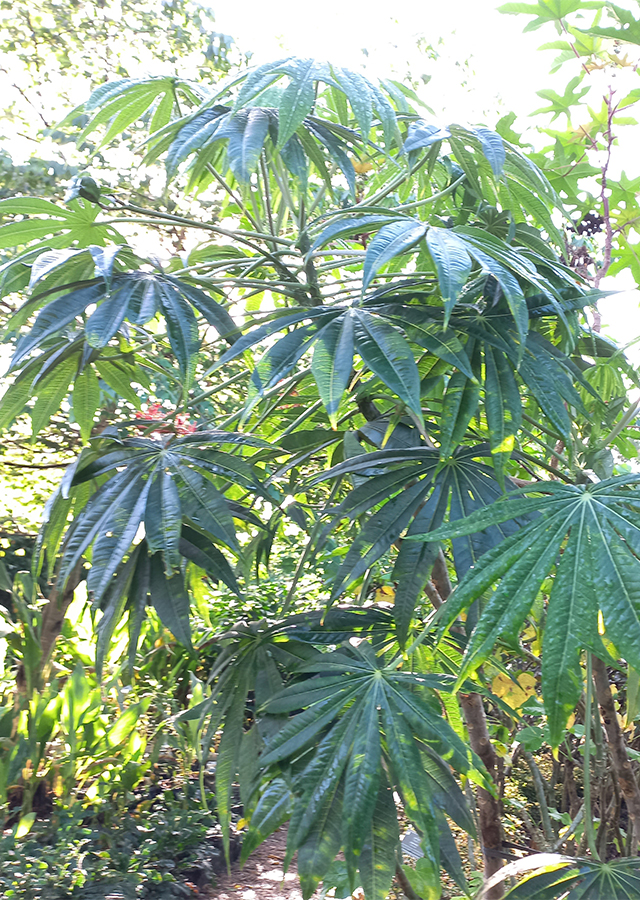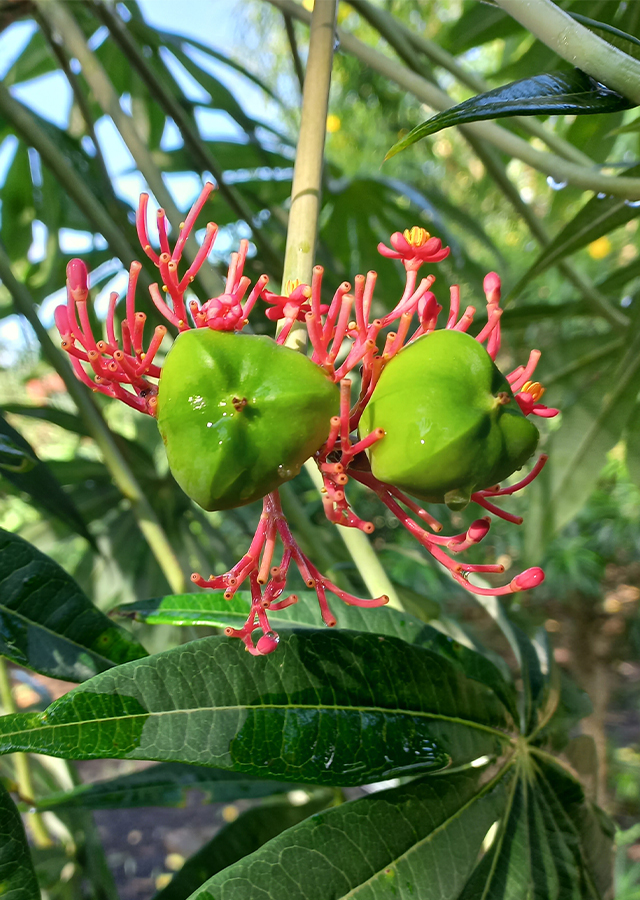Traditional Herbs from Jatropha multifida
bleeding_wound
- Take a medium-sized sprig of Betadine leaves, not too old or young.
- Wait for the tip of the leaf stalk to release a yellowish sap, then stick it on the injured part.
- Wait a few minutes for the sap to dry.
- Repeat this activity two to three times a day.
fever
- Take enough betadine leaves and fruit then wash them until clean.
- Boil them with water until it boils.
- Use water decoction for bathing.
What is Jatropha multifida Looks like??



Parts of Jatropha multifida that could be used
- Leaves
- Seeds
- Latex
- Roots
Jatropha multifida Distribution
Betadine leaves come from the Caribbean, Trinidad, Cuba, southern North America, Mexico. Jatropha multifida L. was introduced as an ornamental plant to tropical areas long ago and is often planted as a hedge. Based on experience from generation to generation, it is widely used by Indonesian people to heal new wounds, so it is known as the betadine plant. Betadine plant stems have been studied in healing wounds and are equivalent in effectiveness to 10% povidone iodine. Betadine plant stems have also been studied to be able to coagulate blood. Betadine plant stem ethanol extract can inhibit the growth of Salmonella typhi.Agroecology of Jatropha multifida
The betadine leaf plant is a semi-arid plant in the tropical lowlands, although it can grow in humid areas as long as there is excellent drainage. Prefers a position in full sun, but also does well in partial shade. Can grow in most well-drained soils. Established plants are somewhat drought tolerant and tolerant of maritime/ocean exposure.
Morphology of Jatropha multifida
- The root has a taproot system, tuberous.
- Woody stem (lignosus) with an enlarged stem base. The shape of the stem is round (teres) the surface is hairy, gummy showing traces of attachment to the leaves. When it is young the stem is green and when it is old it becomes greenish white. The direction of stem growth is perpendicular (erectus). Sympodial branching system (branching is near the ground level), the direction of branch growth is inclined upwards (patens). "Long, single leaves 5-15 cm, 6-16 cm wide. The widest part is in the middle of the leaf blade, from the widest part the shape of the leaf (circumscriptio) of the Jatropha multifida L. plant includes rounded leaves (orbicularis). (acuminatus), the base of the leaf (basis folii) is notched (emarginatus), the upper and lower surfaces of Jatropha multifida L. leaves are gloomy (opacus), finger veins (palminervis), leaf edges (margo folii) are incised (divisus) with shared leaf edges (partitus), where the depth of the notch exceeds half the length of the leaf veins on either side. The location of this notch depends on the arrangement of the leaf veins. So, the term incised leaf edge is a combination of the nature of the notch and the arrangement of the leaf veins (leaves share fingers (palmatipartitus). The layout of the leaves is spread (folia sparsa).\u00a0
- Compound flowers (inflorescentia racemosa), where the flowers grow at the tip stem (flos terminalis). The stem of Inflorescentia racemosa has branched stems and the branches can branch further so that the flowers are not found on the stem stem, type panicles (panicula), the color of the mother flower stalk is green and when it is old it is brown. The flowers are red and are classified as androgynous flowers (hermaphroditus), namely flowers that have stamens (male genitalia) and pistils (female genitalia) . There are eight stamens and the anther is horseshoe-shaped. The color of the stamen itself is yellow. The pistil (pistillum) of the Jatropha multifida L. flower has three fruit leaves attached to each other. There are 5 petals which are not attached (polypetalus). Meanwhile, the flower petals (calyx) have 5 sepals that are attached to each other (gamosepalus) with the calyx being red the same color as the corolla, and based on the number of attached parts (the length and shortness of the points at the top of the petals), the flower petals have a cangap (fissus). ), this is because the attached part covers approximately half the length of the petal, so the tips are approximately half as long). The flower has actinomorphus symmetry, because many planes of symmetry can be created to divide the flower into two equal parts.
- The fruit (fructus) is oval or elliptical with a length of 1 2.5 cm and a diameter of 2-4 cm which is when young it is green and when it is old it is brown. Divided into three chambers, each chamber containing one seed, belonging to the single dry true fruit of the three-vesicle fruit type (tricoccus). ]
Cultivation of Jatropha multifida
Betadine leaf plants are propagated generatively by seeds and vegetatively by stem cuttings.
Jatropha multifida, more details :
Chemical Content of Jatropha multifida
Alkaloid compounds, tannins, glycosides, saponins, flavonoids, phenols, flavone apigenin, acacetin, luteolin, phenolic acids such as vanillic, siring, p-OH-benzoic acid, melilotic, cis- and trans-ferulic; p-coumaric and hydrochloric acids, tannins, proanthocyanidins, and glycoflavones.
Benefits of Jatropha multifida
Used as a laxative and emetic, treating indigestion and colic, as a tonic, orchitis (testicular inflammation), medicine for edema, scabies, wounds and boils, emeto-catharsis, treatment of mouth ulcers, fever, worms and gonorrhea, skin infections, stops external bleeding , abortifacient, treatment of pain, infections, inflammatory conditions, tumors.�
Simplisia of Jatropha multifida
Another Facts for Jatropha multifida :
Synonym of Jatropha multifida
Adenoropium multifidum (L.) Pohl, Jatropha janipha Blanco, Manihot multifida (L.) Crantz
Habitus of Jatropha multifida
Bush. Annual shrub, 2-3 m high
Habitat of Jatropha multifida
- Roadside", "Bush Area", "Land
No comments:
Post a Comment